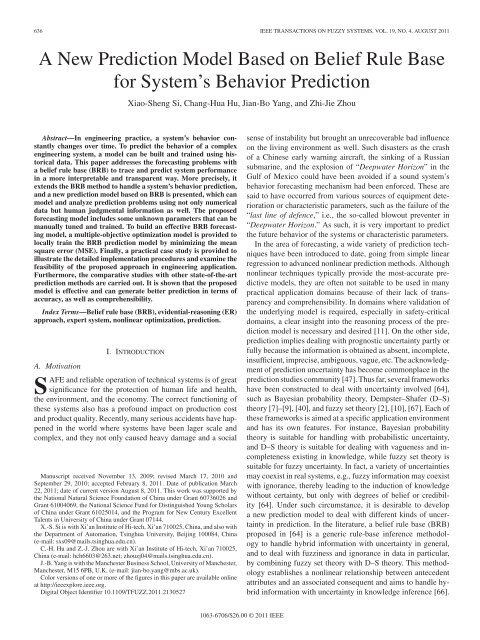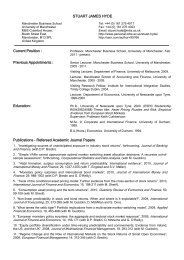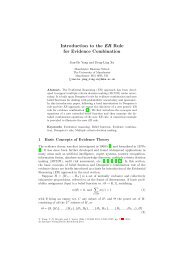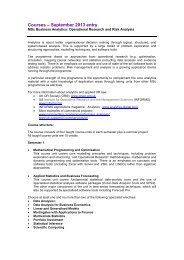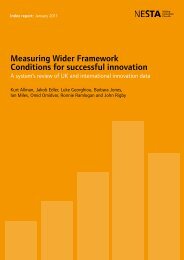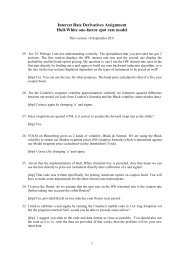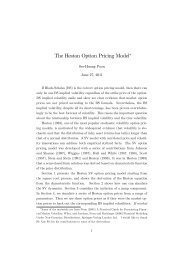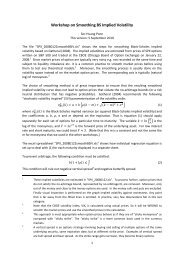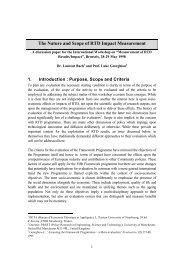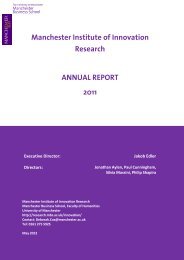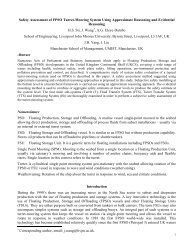A New Prediction Model Based on Belief Rule Base for System's ...
A New Prediction Model Based on Belief Rule Base for System's ...
A New Prediction Model Based on Belief Rule Base for System's ...
You also want an ePaper? Increase the reach of your titles
YUMPU automatically turns print PDFs into web optimized ePapers that Google loves.
SI et al.: NEW PREDICTION MODEL BASED ON BELIEF RULE BASE FOR SYSTEM’S BEHAVIOR PREDICTION 639TABLE IPATTERN OF TRAINING DATASETX is the input nodes and y denotes the predicted output node.Following successful training, the BRB predicti<strong>on</strong> model canpredict future outcomes y t .In the BRB predicti<strong>on</strong> model, the belief rules can be designedas follows:R k : IF x t−1 is A k 1 ∧ x t−2 is A k 2 ···∧x t−p is A k t−pTHEN ŷ t is {(D 1 ,β 1,k ),...,(D N ,β N,k )} with a(2)II. BEHAVIOR PREDICTION MODEL BASEDON BELIEF RULE BASEA. <str<strong>on</strong>g>Model</str<strong>on</strong>g> Structure and Representati<strong>on</strong>In this secti<strong>on</strong>, the predicti<strong>on</strong> model is investigated in theBRB framework. It is assumed that a set of observed data is providedin the <strong>for</strong>m of input–output pairs (X(t m ),y(t m )),m=1,...,M, with X(t m ) being an input vector of the actual systemat time t m and y(t m ) being a scalar or vector representingthe corresp<strong>on</strong>ding output value or subjective distributi<strong>on</strong> valueof the actual system at time t m . In this paper, the input vectorX(t m ) c<strong>on</strong>sists of the antecedent attributes associated withsystem output y(t m ) at time t m .In predicti<strong>on</strong> problem, the inputs used in predicti<strong>on</strong> modelare the past input vector, i.e., lagged observati<strong>on</strong>s of the currenttime, while the outputs are the future values. Each set of inputpatterns is composed of any moving fixed-length window withinthe time series of the input data. The general predicti<strong>on</strong> modelcan be represented asŷ(t + k − 1) = f(x t−1 ,x t−2 ,...,x t−p ) (1)where ŷ(t + k − 1) represents the predicted value at time t,(x t−1 ,x t−2 ,...,x t−p ) is a vector of lagged variables, and prepresents the dimensi<strong>on</strong>s of the input vector (number of inputnodes) or the number of past inputs related to the futurevalue. Although multistep predicti<strong>on</strong> may capture some systemdynamics, the per<strong>for</strong>mance may be poor due to the accumulati<strong>on</strong>of errors. In practice, <strong>on</strong>e-step-ahead predicti<strong>on</strong> results aremore useful since they provide timely in<strong>for</strong>mati<strong>on</strong> <strong>for</strong> preventiveand corrective maintenance plans [57]. In additi<strong>on</strong>, in viewsof Wang [52] and Zhang et al. [69], the more the step is ahead,the less reliable the <strong>for</strong>ecasting operati<strong>on</strong>. Thus, this study <strong>on</strong>lyc<strong>on</strong>siders <strong>on</strong>e-step-ahead predicti<strong>on</strong>, that is, k =1, in (1). Forsimplicity, let X(t) =(x t−1 ,x t−2 ,...,x t−p ) denotes the inputvector of the predicti<strong>on</strong> model.B. C<strong>on</strong>structi<strong>on</strong> of <strong>Belief</strong>-<strong>Rule</strong>-<strong>Base</strong> System<strong>for</strong> Behavior <str<strong>on</strong>g>Predicti<strong>on</strong></str<strong>on</strong>g>In order to c<strong>on</strong>struct BRB predicti<strong>on</strong> model, suppose x t−1 ,x t−2 ,...,x t−p are p antecedent attributes associated withsystem-predicti<strong>on</strong> output ŷ t , and the BRB system approach attemptsto identity the appropriate internal representati<strong>on</strong> betweenX(t) and ŷ t .Table I shows how training patterns can be designed in theBRB predicti<strong>on</strong> model. In Table I, p denotes the number oflagged variables (i.e., so-called embedding dimensi<strong>on</strong>), whilet − p represents the total number of data samples. Moreover,rule weight θ k and attribute weight δ 1,k ,δ 2,k ,...,δ M k ,kwhere x 1 ,x 2 ,...,x t−p represents the antecedent attributes inthe kth rule. A k i (with i =1,...,p,k =1,...,L) is the referentialvalue of the ith antecedent attribute in the kth rule andA k i ∈ A i . A i = {A i,j ,j =1,...,J i } is a set of referential values<strong>for</strong> the ith antecedent attribute and J i is the number ofthe referential values. θ k (∈ R + ,k =1,...,L) is the relativeweight of the kth rule, and δ 1,k ,δ 2,k ,...,δ p,k are the relativeweights of the M k antecedent attributes used in the kth rule.β j,k (j =1,...,N,k =1,...,L) is the belief degree assessedto D j , which denotes the jth c<strong>on</strong>sequent corresp<strong>on</strong>ding to theoutput value at time t. If ∑ Nj=1 β j,k =1,thekth rule is said tobe complete, else it is incomplete. In additi<strong>on</strong>, suppose that p isthe total number of antecedent attributes used in the rule base.A BRB given in (2) represents functi<strong>on</strong>al mappings betweenantecedents and c<strong>on</strong>sequents possibly with uncertainty. It providesa more in<strong>for</strong>mative and realistic scheme than a simpleIF–THEN rule base <strong>for</strong> knowledge representati<strong>on</strong>. Note thatthe degrees of belief β i.k and the weights could be assignedinitially by experts or by comm<strong>on</strong> sense, and then trained orupdated using dedicated learning algorithms [66]. For simplicity,in the following, let us assume that the relative weight ofith antecedent attribute in belief rule k is the same as the relativeweight of this antecedent attribute in belief rule l, wherek =1,...,L,l =1,...,L,k ≠ l. As such, δ i,k can be representedas δ i (i =1,...,p).C. Strategy <strong>for</strong> C<strong>on</strong>verting Available Data to <strong>Belief</strong> StructureWhen applying a BRB, the input of an antecedent is trans<strong>for</strong>medinto a belief structure over the referential values of anantecedent. The distributi<strong>on</strong> is then used to calculate the activati<strong>on</strong>weights of the rules in the rule base. The main advantageof doing so is that precise data, random numbers, and subjectivejudgments with uncertainty can be c<strong>on</strong>sistently modeled underthe same framework [59], [63], [64], [66]. In additi<strong>on</strong>, the ERalgorithm is the inference engine of BRB system, but the ERalgorithm is suitable <strong>for</strong> dealing data in the <strong>for</strong>mat of a beliefstructure [59], [62], [63]. Due to the fact that the input data X(t)may be a numerical value or a subjective distributi<strong>on</strong>, there isa need to trans<strong>for</strong>m these data into the belief structure. In [62],a rule-based scheme to c<strong>on</strong>vert other inputs has been developedto deal with the input in<strong>for</strong>mati<strong>on</strong> involving quantitativedata. In this paper, rule-based trans<strong>for</strong>mati<strong>on</strong> technique can beused <strong>for</strong> data trans<strong>for</strong>mati<strong>on</strong>. For more discussi<strong>on</strong>s <strong>on</strong> this issue,see [62] and [64]. As a result, each input can be represented asa distributi<strong>on</strong> <strong>on</strong> the referential values using a belief structure.By using the rule-based trans<strong>for</strong>mati<strong>on</strong> technique [62], theinput vector X(t) =(x t−1 ,x t−2 ,...,x t−p ) can be described as
640 IEEE TRANSACTIONS ON FUZZY SYSTEMS, VOL. 19, NO. 4, AUGUST 2011TABLE IIREFERENTIAL POINTS OF GYROSCOPIC DRIFTa distributi<strong>on</strong> <strong>on</strong> referential values using a belief structure asfollows:S(x t−i )={(A i,n ,α n,i (x t−i )),n=1,...,J i }, i =1,...,p(3)where A i,n is the nth referential value of the attribute x t−i ,α n,i (x t−i ) is the matching degree, which measures the matchingdegree of the ith input to its nth referential value, and J i isthe number of the referential values used to describe the ithantecedent attribute. From (3), the mass can <strong>on</strong>ly be assignedto the single referential point of the assessment framework.There<strong>for</strong>e, the focal elements under such case are always thesingle grade in the assessment framework.In (3), α n,i (x t−i ) could be obtained using different waysin hand, depending <strong>on</strong> the nature of an antecedent attribute anddata available. Generally, there is a scheme to deal with differenttypes of input in<strong>for</strong>mati<strong>on</strong>, as summarized below [64], [66].1) Quantitative attributes assessed using referential terms:In this case, if the antecedent attribute x t−i can be assessedby defining independent crisp sets, then α n,i (x t−i )can be obtain through rule-based trans<strong>for</strong>mati<strong>on</strong> technique[62]. For example, in the Secti<strong>on</strong> IV-C, the assessmentframework <strong>for</strong> the model inputs is A i = {S, M, L} ={A i,1 ,A i,2 ,A i,3 },<strong>for</strong>i =1and 2. For intuitive illustrati<strong>on</strong>,we used the 35th data point in our dataset to showhow we can obtain the belief structure. As <strong>for</strong> the 35thdata point, the specific inputs are 1.22 ◦ h −1 and 1.26 ◦ h −1 .Taking the first input, i.e., 1.22 ◦ h −1 , <strong>for</strong> instance, we canc<strong>on</strong>vert 1.22 ◦ h −1 as S(1.22) = {(A 1,1 , 0.45),(A 1,2 , 0.55),(A 1,3 ,0)} through rule-based trans<strong>for</strong>mati<strong>on</strong> techniqueand the referential points in Table II. Specifically, we haveα 1,1 (1.22) = (1.4 − 1.22)/(1.4 − 1), and α 2,1 (1.22) =(1.22 − 1)/(1.4 − 1) based <strong>on</strong> the rule-trans<strong>for</strong>mati<strong>on</strong>technique and the referential points in Table II. Other datacan be handled in a similar way, and thus, their descripti<strong>on</strong>is omitted. As a result, each input can be represented as adistributi<strong>on</strong> <strong>on</strong> the referential values using a belief structure.If the assessment of x t−i involves fuzziness, thenA i,j can be defined as fuzzy sets and α n,i (x t−i ) can becalculated via membership functi<strong>on</strong>s [65].2) Quantitative attributes assessed using interval: In thiscase, there are two ways to model input in<strong>for</strong>mati<strong>on</strong> inBRB framework. First, the interval can be seen as a special<strong>for</strong>m of the fuzzy linguistic value; there<strong>for</strong>e, α n,i (x t−i )can be determined in a way similar to the case 1). Thesec<strong>on</strong>d method is that belief structure can be extended toan interval versi<strong>on</strong> [53], and then, α n,i (x t−i ) can be generatedthrough rule-based trans<strong>for</strong>mati<strong>on</strong> technique, butα n,i (x t−i ) is also in the <strong>for</strong>mat of interval in such a case.For details, see [53].3) Qualitative or symbolic attributes assessed using subjectivejudgments. In this case, the belief degree α n,i (x t−i ) isassigned directly by the decisi<strong>on</strong> maker using his subjectivejudgments <strong>for</strong> each referential value or each symbolicterm. For example, if ε n,i (x t−i ) is the belief degree assignedto the symbolic term or the referential term A i,j bythe decisi<strong>on</strong> maker, then α n,i (x t−i )=ε n,i (x t−i ).D. Calculating the Output of <strong>Belief</strong>-<strong>Rule</strong>-<strong>Base</strong><str<strong>on</strong>g>Predicti<strong>on</strong></str<strong>on</strong>g> <str<strong>on</strong>g>Model</str<strong>on</strong>g>When the antecedent attribute, such as the inputs of the BRB,is available, the ER approach serves as the inference engine ofBRB predicti<strong>on</strong> model, which mainly c<strong>on</strong>sists of following twosteps.1) Step 1: Calculati<strong>on</strong> of the Activati<strong>on</strong> Weight of <strong>Belief</strong> <strong>Rule</strong>:The activati<strong>on</strong> weight of the kth rule ω k at time t is calculatedby∏θ M k k i=1ω k (t) =(αk j,i (t − i))¯δ i∑ Ll=1 θ ∏ M kl i=1 (αl j,i (t − andi))¯δ iδ i¯δ i =(4)max i=1,...,Mk {δ i }where δ i,k (∈ R + ,i=1,...,M k ) is the relative weight of theith antecedent attribute that is used in the kth rule. Because ω kwill be eventually normalized so that ω k ∈ [0, 1] using (4), θ kand δ i,k can be assigned to any value in R + . Without loss of generality,however, we assume that θ k ∈ [0, 1](<strong>for</strong> k =1,...,L)and δ i,k ∈ [0, 1](<strong>for</strong> i =1,...,M k ). αi,j k (<strong>for</strong> i =1,...,M k ),which is called the individual matching degree, is the degreeof belief to its jth referential value A k i,j in the kth rule.α k = ∏ M ki=1 (αk i,j )¯δ iis called the normalized combined matchingdegree.2) Step 2: <strong>Rule</strong> Inference Using the Evidential-Reas<strong>on</strong>ingApproach: Using the analytical ER algorithms [51], the finalc<strong>on</strong>clusi<strong>on</strong> O (ŷ(t)) that is generated by aggregating allrules that are activated by the actual input vector X(t) =(x t−1 ,x t−2 ,...,x t−p ) at time instant t can be represented asfollows:O(ŷ(t)) = F (X(t)) = {(D j , ˆβ j (t)),j =1,...,N} (5)where O(ŷ(t)) denotes the predicted output of predicti<strong>on</strong> modelin the <strong>for</strong>mat of belief structure, and ˆβ j (t) denotes the predictedbelief degree in D j at time instant t. The aggregated resultO(ŷ(t)) represents the overall assessment of system’s behaviorand provides a complete picture about the system state at time t,from which <strong>on</strong>e can tell which assessment grades the system’sbehavior is assessed to, and what belief degrees are assigned tothe defined assessment grades D n ,n=1,...,N.In(5), ˆβ j (t)can be <strong>for</strong>mulated as follows [51]:ˆβ j (t) = μ(t) × ∏ L(k=1 ωk (t)β j,k (t)+1− ω k (t) ∑ Ni=1 β i,k(t) )1 − μ(t) × [∏ Lk=1 (1 − ω k (t)) ]− μ(t) × ∏ Lk=1(1 − ωk (t) ∑ Ni=1 β i,k(t) )1 − μ(t) × [∏ Lk=1 (1 − ω k (t)) ] (6)
SI et al.: NEW PREDICTION MODEL BASED ON BELIEF RULE BASE FOR SYSTEM’S BEHAVIOR PREDICTION 641⎡ ()N∑ L∏N∑μ(t) = ⎣ ω k (t)β j,k (t)+1− ω k (t) β i,k (t)j=1 k=1k=1i=1(−1L∏N∑− (N − 1) 1 − ω k (t) β i,k (t))](7)where ω k (t) is calculated by (4). Note that ˆβ j (t) is the functi<strong>on</strong>of β i,k , θ k , δ i , and X(t).As shown in (5), we can see that the default output <strong>for</strong>matof BRB predicti<strong>on</strong> model is belief distributi<strong>on</strong>. However, insome engineering applicati<strong>on</strong>s, a numerical output value ŷ(t) isrequired and preferred, such as pipeline-leak detecti<strong>on</strong> in [58].To achieve this aim, the c<strong>on</strong>cept of utility in decisi<strong>on</strong> theoryand utility-based trans<strong>for</strong>mati<strong>on</strong> technique [62] can be usedto c<strong>on</strong>vert the distributed assessment O (ŷ(t)) to a numericaloutput ŷ(t). It is dem<strong>on</strong>strated that the two are equivalent in thesense that they both represent the same states of the system [62].For detailed implementati<strong>on</strong>, see [58] and [62].From (6) to (7), it can be seen that belief degrees β i,k , attributeweights δ m , and rule weights θ k play a significant role in the finalc<strong>on</strong>clusi<strong>on</strong> O(ŷ(t)). The degree to which the final output canbe affected is determined by the magnitude of the belief degrees,attribute weights, and rule weights. On the other hand, if the parametersof the BRB predicti<strong>on</strong> model, such as θ k ,δ m , and β j,k ,are not given apriorior <strong>on</strong>ly known partially or imprecisely,they could be trained using observed input and output in<strong>for</strong>mati<strong>on</strong>.There<strong>for</strong>e, the inference per<strong>for</strong>mance of BRB predicti<strong>on</strong>systems and the proposed model can be improved if the <strong>for</strong>egoingunknown parameters with some c<strong>on</strong>straints are adjusted byoptimizati<strong>on</strong> algorithm. The c<strong>on</strong>structi<strong>on</strong> of the c<strong>on</strong>straints ofthe unknown parameters in BRB predicti<strong>on</strong> model is given asfollows [66].1) A belief degree must not be less than 0 or more than 1,i.e.,i=10 ≤ β j,k ≤ 1, j =1,...,N, k =1,...,L. (8)2) If the kth belief rule is complete, its total belief degree inthe c<strong>on</strong>sequent will be equal to 1, i.e.,∑ N β j,k =1. (9)j=1Otherwise, the total belief degree is less than 1.3) A rule weight is normalized, so that it is between 0 and 1,i.e.,0 ≤ θ k ≤ 1, k =1,...,L. (10)4) A attribute weight is normalized so that it is between 0and 1, i.e.,0 ≤ δ i ≤ 1, i =1,...,p (11)As such, there is a need to develop a method that can learnparameters of BRB predicti<strong>on</strong> model using observed input andoutput in<strong>for</strong>mati<strong>on</strong>. This is exactly discussed in the following.III. PARAMETERS OPTIMIZATION FOR BELIEF-RULE-BASEPREDICTION MODELAs discussed in [64] and [66], belief rule in a BRB may initiallybe provided by human experts based <strong>on</strong> individual experienceand pers<strong>on</strong>al judgments and then optimally trained if theobserved input–output data are available. In additi<strong>on</strong>, a changein unknown parameters θ k ,δ m , and β j,k may lead to changesin the per<strong>for</strong>mance of the BRB predicti<strong>on</strong> model. There<strong>for</strong>e, itis preferred to c<strong>on</strong>struct optimizati<strong>on</strong> model <strong>for</strong> training predicti<strong>on</strong>model. Inherited from the training process <strong>for</strong> general BRBsystem developed in [66], <strong>on</strong>e optimizati<strong>on</strong> model is developedto train the proposed predicti<strong>on</strong> model.First, we assume that a set of observati<strong>on</strong> pairs (X(t m ),y(t m )),m=1,...,M is available, where X(t m )is an inputvector at time t m , and y(t m ) is the observed output accordingly.Depending <strong>on</strong> the types of input and output, the optimal learningmodels can be c<strong>on</strong>structed in different ways [19], [28], [66]. Inthis paper, we <strong>on</strong>ly c<strong>on</strong>sider the case that the output is in the<strong>for</strong>mat of belief structure. Then, in the following, y(t m ) can bewritten asy(t m )={(D n ,β n (t m )),n=1,...,N} (12)where D n is a system-state evaluati<strong>on</strong> grade of system used inthe BRB predicti<strong>on</strong> model, and β n (t m ) is the degree of beliefto which D n is assessed <strong>for</strong> the mth pair of observed data attime t m .Using the same system-state evaluati<strong>on</strong> grades as <strong>for</strong> the observedoutput y(t m ), a belief distributi<strong>on</strong> c<strong>on</strong>clusi<strong>on</strong> that isgenerated by aggregating all the activated rules in the BRBpredicti<strong>on</strong> system can also be represented as follows:ŷ(t m )={(D n , ˆβ n (t m )),n=1,...,N} (13)where ˆβ n (t m ) is generated by (6) and (7) <strong>for</strong> a given input vectorX(t m ). It is desirable that, <strong>for</strong> a given input X(t m ), the BRBpredicti<strong>on</strong> model can generate an output ŷ(t m ), as representedin (13), which can be as close to y(t m ) as possible. In otherwords, <strong>for</strong> the mth pair of the observed data (X(t m ),y(t m )),it is required that the BRB predicti<strong>on</strong> model is trained to minimizethe MSE between the observed belief β n (t m ) and thebelief ˆβ n (t m ) that is generated by the BRB predicti<strong>on</strong> model<strong>for</strong> each referential term. C<strong>on</strong>sequently, the training problemunder this case is a multiobjective optimizati<strong>on</strong> problem sincethe <strong>for</strong>egoing requirement is true <strong>for</strong> all evaluati<strong>on</strong> grades. Theminimax method can be used to solve such multiobjective optimizati<strong>on</strong>problem [28], [30], [31], where the objective functi<strong>on</strong>can be written aswithξ j (Q) = 1 MminQmax {φ j ϕ j (Q)}j=1,...,Ns.t. (8)–(11)(14)M∑(β j (t m ) − ˆβ j (t m )) 2 , j =1,...,N (15)m =1ϕ j (Q) = ξ j (Q) − ξ ∗ jξ + j − ξ ∗ j(16)
642 IEEE TRANSACTIONS ON FUZZY SYSTEMS, VOL. 19, NO. 4, AUGUST 2011ξ + j − ξ ∗ j > 0, j =1,...,N (17)where Q = {β j,k ,θ k ,δ i } is the training parameter vectorwith j =1,...,N,k =1,...,L,i=1,...,p, and ξ j (Q) is theMSE between the observed belief β j (t m ) and the predicted beliefˆβ j (t m ) by the BRB predicti<strong>on</strong> model <strong>for</strong> the jth referentialterm. In this case, the optimizati<strong>on</strong> problem involves N objectivefuncti<strong>on</strong>s, L + L × N + p training parameters given as Qand L × N +2L + p c<strong>on</strong>straints.In (14), φ j is the weighting parameter representing the relativeimportance of the jth objective functi<strong>on</strong> c<strong>on</strong>strained with0 ≤ φ j ≤ 1 and ∑ Nj=1 φ j =1. In this paper, <strong>for</strong> simplicity,φ j is set to be equivalent <strong>for</strong> all objective functi<strong>on</strong>s, i.e.,φ j =(1/N ),j =1,...,N. ξ + j and ξj ∗ are the feasible maximumand minimum values <strong>for</strong> the jth objective functi<strong>on</strong>, asdefined in (15). It can be seen from (14) to (17) that the optimizedobjective is a functi<strong>on</strong> of parameter vector Q, while theelements of Q are c<strong>on</strong>strained in the c<strong>on</strong>tinuous regi<strong>on</strong>, as definedin (8)–(11). In this sense, we can see that β j,k ,θ k , and δ iare c<strong>on</strong>tinuous variables, and there is no discrete variable optimizedin (14). As shown in (6) and (7), ˆβ j (t) is a functi<strong>on</strong> ofβ j,k ,θ k , and δ i , and thus, the optimized objective functi<strong>on</strong> canbe c<strong>on</strong>sidered to be c<strong>on</strong>tinuous. There<strong>for</strong>e, such a minimax optimizati<strong>on</strong>model can be solved using MATLAB optimizati<strong>on</strong>toolbox with FMINIMAX functi<strong>on</strong>. In additi<strong>on</strong>, we note thatthis functi<strong>on</strong> FMINIMAX has been used <strong>for</strong> a similar purposein [28] and [66]. Once the input–output data become available,the related parameters to the BRB predicti<strong>on</strong> model canbe obtained rati<strong>on</strong>ally. Then, the system’s behavior state can bepredicted when the new in<strong>for</strong>mati<strong>on</strong> becomes available.IV. DEMONSTRATION OF BELIEF-RULE-BASE PREDICTIONMODEL: APRACTICAL CASE STUDYIn this secti<strong>on</strong>, a practical case study is examined to validatethe BRB predicti<strong>on</strong> model under the distributed outputs andto show the applicati<strong>on</strong> potential of BRB predicti<strong>on</strong> model inengineering practice.As a key device of INSs in weap<strong>on</strong> systems and space equipments,an inertial navigati<strong>on</strong> plat<strong>for</strong>m plays an irreplaceableimportant role and its operating state has a direct influence <strong>on</strong>navigati<strong>on</strong> precisi<strong>on</strong>. In our tested inertial navigati<strong>on</strong> plat<strong>for</strong>m,the sensors are fixed in it, which mainly include three DTGsand three accelerometers, measuring angular velocity and linearaccelerati<strong>on</strong>, respectively. Statistical analysis shows that almost80% failures of inertial plat<strong>for</strong>ms result from gyroscopic drift.In our case, the gyro fixed <strong>on</strong> an inertial plat<strong>for</strong>m is a mechanicalstructure having 2 degrees of freedom from the driver and senseaxis. For a general descripti<strong>on</strong> of an inertial navigati<strong>on</strong> plat<strong>for</strong>mand gyros, see [55]. When the inertial plat<strong>for</strong>m is operating,the rotating wheel of DTGs with very high speed can lead torotati<strong>on</strong> axis wear, and finally, result in gyro’s drift. With accumulati<strong>on</strong>of wear, the drift degrades, and finally, results in thefailure of DTGs. Especially, several fails in launching, which areresulted by the abnormality of the DTGs, are str<strong>on</strong>gly driving<strong>for</strong>ces <strong>for</strong> building reliable and cost-effective predicti<strong>on</strong> modelthat can provide the complete picture of the DTG by analyzingFig. 1.Entire gyroscopic drift data collected in the trial.the changing trend of the DTG drift. As such, the drift of DTGsis usually used as a per<strong>for</strong>mance indicator to evaluate the healthc<strong>on</strong>diti<strong>on</strong> of an inertial plat<strong>for</strong>m. Since such DTG is widely usedin aer<strong>on</strong>autic c<strong>on</strong>trol system with safety-critical requirement, itis desired that the adopted model is not <strong>on</strong>ly comprehensible byhuman expert, but also transparent with inference process, andcan provide some explanati<strong>on</strong>s of the predicted results. As analyzedabove, the BRB predicti<strong>on</strong> model can satisfy these desiresin the sense that it can provide a complete picture <strong>on</strong> the stateof DTG, such as the belief degree <strong>on</strong> each assessment grade.In our study, we <strong>on</strong>ly take the drift-degradati<strong>on</strong> measuremental<strong>on</strong>g the sense axis <strong>for</strong> an illustrati<strong>on</strong> purpose since this variableplays a dominant role in the assessment of gyros degradati<strong>on</strong>.The dem<strong>on</strong>strati<strong>on</strong> of the proposed model is c<strong>on</strong>ducted in thefollowing and some comparative studies are provided as well.A. Problem Descripti<strong>on</strong>In this study, the system’s drift data are collected in a DTGper<strong>for</strong>mance reliability trial from leaving factory. For the DTGdrift trial, some technical parameters include the sampling intervalT , the accelerati<strong>on</strong> of gravity g, and the geographic latitudeR. In this experiment, T =2.2 h, g = 979.4121 cm/s 2 ,and R =34.6006 ◦ , where a PC-based data-acquisiti<strong>on</strong> systemis used to acquire and store the drift data. After the experiment,we can collect all the drift data. The datasets include the timeto-driftdata <strong>for</strong> 90 suits of gyroscope. The experiment resultsare illustrated in Fig. 1.As shown in Fig. 1, it indicates that the gyroscopic drift isa time series. There<strong>for</strong>e, it is reas<strong>on</strong>able to assume that thecurrent gyroscopic drift value y t is related to the most recenty t−1 , or even extended into the past values y t−2 ,...,y t−p .Thisis because the next gyroscopic drift value is dependent <strong>on</strong> thecurrent level of gyroscope state to a certain extent. As such, y t−ican be treated as the antecedent attributes of the rule base, wherei =1,...,p. In next secti<strong>on</strong>, the BRB predicti<strong>on</strong> model will beestablished to predict the behavior of DTG at time t based <strong>on</strong>y t−1 ,y t−2 ,...,y t−p .
SI et al.: NEW PREDICTION MODEL BASED ON BELIEF RULE BASE FOR SYSTEM’S BEHAVIOR PREDICTION 643B. <str<strong>on</strong>g>Predicti<strong>on</strong></str<strong>on</strong>g> <str<strong>on</strong>g>Model</str<strong>on</strong>g> <str<strong>on</strong>g><strong>Base</strong>d</str<strong>on</strong>g> <strong>on</strong> the <strong>Belief</strong>-<strong>Rule</strong>-<strong>Base</strong> ApproachThe BRB system is used to capture the relati<strong>on</strong>ship am<strong>on</strong>gy t−1 ,y t−2 ,...,y t−p through system state after p steps, whichcaptures the dynamics of DTG. This kind of BRB system canbe c<strong>on</strong>sidered as the <strong>for</strong>ecasting model and used to predict thefuture behavior of the system. Thus, the predicti<strong>on</strong> BRB systemcan be c<strong>on</strong>structed as follows:R k : IF y t−1 is A k 1 ∧ y t−2 is A k 2 ···∧y t−p is A k p , THENsystem state at next step is {(D 1 ,β 1,k ),...,(D N ,β N,k )}with a rule weight θ k and attribute weight δ 1 ,δ 2 ,...,δ p .For simplicity, this study experimented with a relatively smallernumber p, and then, two antecedent attributes are selected as anexample. C<strong>on</strong>sequently, we can trans<strong>for</strong>m 90 observed valuesto 88 sets of input–output patterns according Table I. Then, thebelief rule can be represented as follows:R k : IF y t−1 is A k 1 ∧ y t−2 is A k 2 , THEN system stateat next step is {(D 1 ,β 1,k ),...,(D N ,β N,k )} with arule weight θ k and attribute weight δ 1 ,δ 2 ,...,δ pwhere R k (k =1,...,L) is the belief rules of the BRB. In theBRB, A k 1 and A k 2 are the referential points of y t−1 and y t−2 ,respectively. D l (l =1,...,N) are the assessment grades ofsystem’s behavior.C. Referential Points of the Antecedents and C<strong>on</strong>sequenceFrom Fig. 1, we can see that the original input data wereall provided as numerical numbers; there<strong>for</strong>e, there is a needto equivalently trans<strong>for</strong>m the numerical value into the beliefstructures. Note that the referential values of an attribute andthe types of input in<strong>for</strong>mati<strong>on</strong> are problem specific [26], [59].In this case study, the technical requirement of DTG is that thedrift value is not larger than 2.4 ◦ h −1 ; there<strong>for</strong>e, the linguisticlabels <strong>for</strong> y t−1 ,y t−2 are defined as “Small”(S), “Medium”(M),and “Large” (L). i.e., A k i ∈{S, M, L} <strong>for</strong> i =1and 2. Forthesystem’s behavior state, three assessment grades of system’sbehavior <strong>for</strong> outputs of BRB predicti<strong>on</strong> system are used, andthey are “Good” (G), “Average” (A), and “Poor” (P ); this isto say that D =(D 1 ,D 2 ,D 3 )=(G, A, P ). As such, in ruleR k (k =1,...,L) in above secti<strong>on</strong>, L =9and N =3.The referential points of inputs defined above are in linguisticterms and need to be quantified. In [62], a scheme to c<strong>on</strong>vertother inputs to belief structure has been developed. In theproposed scheme, there is an important technique, i.e., rulebasedin<strong>for</strong>mati<strong>on</strong>-trans<strong>for</strong>mati<strong>on</strong> technique, which is used todeal with the input/output in<strong>for</strong>mati<strong>on</strong> involving quantitativedata. After data trans<strong>for</strong>mati<strong>on</strong>, quantitative data can be trans<strong>for</strong>medto belief structures, and the two are equivalent in thesense that they both represent the same states of the system. Formore details, see [62]. The quantified results in this case studyare listed in Table II.D. Simulati<strong>on</strong> Results Under <strong>Belief</strong> Distributi<strong>on</strong> OutputTo validate the BRB predicti<strong>on</strong> model, the available data arepartiti<strong>on</strong>ed into a training dataset and a testing dataset. The trainingdataset is used to train the BRB-predicti<strong>on</strong>-model parameters.In this case, the output is trans<strong>for</strong>med into the followingdistributed output <strong>for</strong>mat:S(output) ={(D 1 ,β 1 ), (D 2 ,β 2 ), (D 3 ,β 3 )}where β i ,i=1, 2, and 3 can be obtained by the rule-basedin<strong>for</strong>mati<strong>on</strong>trans<strong>for</strong>mati<strong>on</strong>. Since the gyroscopic drift is a timeseries and the input–output patterns are c<strong>on</strong>structed by Table I,we use the same referential points as given in Table II <strong>for</strong> theassessment grades of system’s behavior D i ,i=1, 2, and 3,respectively.As such, according to Table II, <strong>on</strong>e of trans<strong>for</strong>mati<strong>on</strong>rules <strong>for</strong> system-assessment grade D 1 could be read as follows:If gyroscopic drift is 1.0 ◦ h −1 , then system’s behavior state isranked to be “Good” with the matched degree 1.0, i.e., D 1 =1.0.The other two trans<strong>for</strong>mati<strong>on</strong> rules can be interpreted in a similarway. For instance, using the defined referential points, the35th data with output value 1.28 ◦ h −1 in our dataset can be trans<strong>for</strong>medinto S(output) = {(D 1 ,0.7),(D 2 ,0.3),(D 3 ,0)} based <strong>on</strong>rule-based trans<strong>for</strong>mati<strong>on</strong> technique. Similar to the example inSecti<strong>on</strong> II-C, we have β 1 =(1.4 − 1.28)/(1.4 − 1) = 0.3, andβ 2 =(1.28 − 1)/(1.4 − 1) = 0.7. In fact, this process is similarto fuzzificati<strong>on</strong> step used in fuzzy set theory [2], [10]. However,it is worth noting that the referential values used in the aboverules are problem-dependent. In our case study, it is usually requiredthat the drift of the DTG is not larger than 2.4 ◦ h −1 sincethe DTG is used in a safety-critical system.In this case study, three BRB predicti<strong>on</strong> systems are c<strong>on</strong>structed<strong>for</strong> this validati<strong>on</strong> analysis. The first BRB is directlyc<strong>on</strong>structed from expert knowledge about the relati<strong>on</strong>ship betweensystem’s behavior and drift, which simulated the uncertainin<strong>for</strong>mati<strong>on</strong> in system’s behavior predicti<strong>on</strong>. The sec<strong>on</strong>dBRB is given by an engineering practiti<strong>on</strong>er. Then, it is trainedusing the proposed optimizati<strong>on</strong> method and the data are generatedfrom the first BRB, thus leading to the third optimallytrained BRB. Finally, the trained BRB predicti<strong>on</strong> model is usedto predict outputs <strong>for</strong> the testing input data. In order to make ourfollowing listed steps clear, we select the 35th data used in ourdataset to illustrate and track the changes in each step.1) Step 1: Directly C<strong>on</strong>struct a Benchmark <strong>Belief</strong> <strong>Rule</strong> <strong>Base</strong>According to the Prior Knowledge: In engineering practice, theDTG drift values change over time, as shown in Fig. 1. The inertialsystem presents great requirement to the precisi<strong>on</strong> of DTG.In practice, DTG drift as an indicati<strong>on</strong> of per<strong>for</strong>mance of DTGis the smaller the better, i.e., if the drift value is large, then thebehavior of DTG can be assessed to “Poor” with great possibility.<str<strong>on</strong>g><strong>Base</strong>d</str<strong>on</strong>g> <strong>on</strong> this principle, a benchmark BRB is c<strong>on</strong>structedthrough expert interventi<strong>on</strong>, as shown in Table III.In the benchmark BRB, the values of θ k and δ i are all set to1, where k =1,...,9, and i =1,...,2, except θ 3 ,θ 5 , and θ 7 .For example, the value of θ 3 is 0.9, which is less than 1.0, whichrepresents that the rule 3 has a low credibility. To some extent,this reflects the knowledge that we have obtained is not completeand some uncertainties exist in assessment results. This BRBis used as a benchmark to check how closely a BRB, whichis initialized either using historical or using expert knowledge,can be trained using the proposed training algorithm to simulate
644 IEEE TRANSACTIONS ON FUZZY SYSTEMS, VOL. 19, NO. 4, AUGUST 2011TABLE IIIBENCHMARK BRB PREDICTION SYSTEMthe true relati<strong>on</strong>ship. There<strong>for</strong>e, the BRB shown in Table III isreferred to as benchmark BRB <strong>for</strong> short.To apply the benchmark BRB to c<strong>on</strong>struct the benchmarkdistributed outputs, the input values of y t−1 and y t−2 als<strong>on</strong>eed to be trans<strong>for</strong>med and represented in terms of the referentialvalues in the <strong>for</strong>m of A k i ∈{S, M, L}. Then, (6) and(7) are used to generate the distributed outputs of the benchmarkBRB, as defined in Table III. The generated distributedoutputs are then used to be the true behavior state <strong>for</strong> thebenchmark distributed outputs. Since the inputs data of the 35thdata used in our dataset has been c<strong>on</strong>verted into the requiredbelief structure, the output of the benchmark BRB predicti<strong>on</strong>system <strong>for</strong> this data point can be computed by (6) and (7) as{(D 1 , 0.749) , (D 2 , 0.1425) , (D 3 , 0.1085)}. Other data can beobtained in a similar way. The distributed outputs of the benchmarkBRB are shown graphically in Fig. 2(a)–(c).2) Step 2: Set the Parameters of the Initial <strong>Belief</strong> <strong>Rule</strong> <strong>Base</strong>:The belief degrees in the initial BRB are given and listed inTable IV. The initial values of θ k and δ i are all set to 1, where k =1,...,9, and i =1and 2. The initial belief degrees in Table IVare determined by the expert knowledge according to the runningpatterns and historical data of the DTG and the change of thedrift values over time. For example, according to the historicalin<strong>for</strong>mati<strong>on</strong>, if y t−1 is “Small” and y t−2 is “Small,” the expertjudges that the possibility of system in the “Good” state islarger than the other states. There<strong>for</strong>e, the expert may assessthat the belief degree to “Good” is 0.95 and the belief degreeto “Average” is 0.05 and to “Poor” is 0, respectively. Thus, theinitial belief rule can be obtained as the sec<strong>on</strong>d row of Table IV.The other rules can be initialized in a similar way.Once the initial BRB predicti<strong>on</strong> system is c<strong>on</strong>structed, it canbe used to predict the system’s behavior. For illustrati<strong>on</strong> purposes,all sets of sampling data are used <strong>for</strong> testing the per<strong>for</strong>manceof the initial BRB. As shown in Fig. 2(a)–(c), we canobserve that the belief degrees to the c<strong>on</strong>sequents calculated by(6) and (7) using the initial BRB do not match well the distributedoutputs generated by the benchmark BRB, as defined inTable III. Similar to step 1, the output of the initial BRB predicti<strong>on</strong>system <strong>for</strong> the 35th data can be computed by (6) and (7) as{(D 1 , 0.8579) , (D 2 , 0.1106) , (D 3 , 0.0314)}. Obviously, thereare significant difference between the output of the benchmarkBRB and the initial BRB. This means that the initial rule baseFig. 2. Predicted results of BRB predicti<strong>on</strong> model being (a) “good,”(b) “average,” and (c) “poor.”provided by the expert is not good enough. There<strong>for</strong>e, it is necessaryto use the available in<strong>for</strong>mati<strong>on</strong> to train the rule base bythe optimizati<strong>on</strong> approach.
SI et al.: NEW PREDICTION MODEL BASED ON BELIEF RULE BASE FOR SYSTEM’S BEHAVIOR PREDICTION 645TABLE IVINITIAL BRB PREDICTION SYSTEMTABLE VTRAINED BRB PREDICTION SYSTEM3) Step 3: Train the <strong>Belief</strong> <strong>Rule</strong> <strong>Base</strong> C<strong>on</strong>structed Initiallyin Step 2: After the input values y t−1 and y t−2 are trans<strong>for</strong>medand represented in terms of referential values, based <strong>on</strong> the datagenerated <strong>for</strong> c<strong>on</strong>structi<strong>on</strong> of the benchmark BRB, as shown instep 1, and the initial BRB, as given by the expert in step 2, theoptimizati<strong>on</strong> models (14)–(17) are used to train the initial BRB.For illustrati<strong>on</strong> purposes, the first 50 sets of data are used as thetraining data <strong>for</strong> parameter estimati<strong>on</strong>. In this simulati<strong>on</strong>, theerror tolerance is set to 0.05 and the maximum iterati<strong>on</strong> is setto 100 to avoid dead loop in the optimal learning process. Thetrained results are listed in Table V.After training, the remaining 38 sets of data are used <strong>for</strong>testing the trained BRB predicti<strong>on</strong> model. The test results areillustrated in Fig. 2(a)–(c), where the comparis<strong>on</strong>s are shownbetween the actual output and the predicted output that is generatedusing the trained BRB predicti<strong>on</strong> model and the initial <strong>on</strong>e.It is clear that the distributed outputs generated by the trainedBRB system can match the benchmark BRB more closely thanthe initial BRB. Similar to the previous two steps, the outputof the trained BRB predicti<strong>on</strong> system <strong>for</strong> the 35th data can beobtained as {(D 1 , 0.7748) , (D 2 , 0.1407) , (D 3 , 0.1145)}. Thisfurther dem<strong>on</strong>strates that the trained BRB can match the benchmarkBRB accurately and the established optimizati<strong>on</strong> methodcan work well.As discussed in Secti<strong>on</strong> I, we can see that probabilistic interpretati<strong>on</strong>is possible in our case here since the belief degree is<strong>on</strong>ly assigned to the single grade of the assessment framework inthe BRB model. This result arises from rule-based trans<strong>for</strong>mati<strong>on</strong>technique and ER algorithm. There<strong>for</strong>e, we can c<strong>on</strong>siderbelief degree as a generalized probability from either Dempster’slower and upper probability [7]–[9] or Smets’ pignisticprobability [41] viewpoints. In the following, we can give aclear interpretati<strong>on</strong> of the predicted outputs and assessed results.Taking the predicted curve being grade “Good” [see Fig. 2(a)],<strong>for</strong> example, we can read from probabilistic viewpoint that theprobability of DTG system’s behavior assigned to grade “Good”increases from 0.1998 to 0.724 m<strong>on</strong>ot<strong>on</strong>ously and then experiencesa fluctuating process around 0.72. The reas<strong>on</strong> that thebelief degree assigned to grade “Good” is below 0.5 in the firstseven sampling period lies in the fact that this kind of DTG isnot stable at the beginning of its operating time. As shown inFig. 2(a), the belief degree assigned to grade “Good” is around0.72 with the steady operati<strong>on</strong> of DTG system, i.e., the functi<strong>on</strong>of DTG is good almost with the probability value 0.72. Atthe same time, the probability of system’s behavior assignedto grade “Poor” is small. The other cases can be analyzed in asimilar way. From the above analysis, we can c<strong>on</strong>clude that thefuncti<strong>on</strong> and behavior of DTG is normal in this case and that theproposed method can give complete picture about the operatingstate of DTG. These results can provide valuable in<strong>for</strong>mati<strong>on</strong><strong>for</strong> c<strong>on</strong>ducting cost-effective maintenance and avoiding a largecalamity.4) Step 4: Per<strong>for</strong>mance Evaluati<strong>on</strong>: In this secti<strong>on</strong>, the resultsof predicted results using BRB predicti<strong>on</strong> model will bediscussed. The histograms of the absolute difference betweenthe actual and the predicted by the initial BRB and the trainedBRB are shown in Fig. 3.It can be seen that the absolute errors of most of samplesusing trained BRB are less than 0.01 in terms of assessment“Good,” as shown in Fig. 3(b), when compared with the rangeof the predicted results in Fig. 2(a). For the predicted values interms of assessment “Average” and “Poor,” the histograms ofthe absolute errors are shown in Fig. 3(b). All predicted resultsof trained BRB model are acceptable. In c<strong>on</strong>trast, the absoluteerrors of most of samples using the initial BRB model are closeto 0.1 in terms of assessment “Good,” as shown in Fig. 3(a).In order to further dem<strong>on</strong>strate the proposed method, fivemeasures of <strong>for</strong>ecasting per<strong>for</strong>mance are introduced [34],[45], [46], including mean absolute percentage error (MAPE),root MSE (RMSE), Teil’s inequality coefficient (TIC), Teil’sU-statistics (TUS), and modeling efficiency (ME). These indicatorsare all based <strong>on</strong> <strong>for</strong>ecast residuals and are widely employedin the realm of <strong>for</strong>ecasting practice. The detailed mathematicalexpressi<strong>on</strong>s are summarized in Table VI. The measures MAPEand RMSE have been widely used in predicti<strong>on</strong> field to testthe accuracy of the predicti<strong>on</strong> model [6], [22], [24], [54], [56],where RMSE can, in part, measure the variance character inpredicted results. Here, we report <strong>on</strong> additi<strong>on</strong>al measures TIC,TUS, and ME since they provide some simple per<strong>for</strong>mances <strong>on</strong>relative scale that can avoid the scaling problem of both MAPEand RMSE. If TIC = 0orTUS= 0, then the model produces
646 IEEE TRANSACTIONS ON FUZZY SYSTEMS, VOL. 19, NO. 4, AUGUST 2011Fig. 3Histogram of absolute difference by (a) initial BRB, (b) trained BRB, (c) BRF neural networks, (d) ARMA/GARCH, (e) FCM-TS model, and (f) LSSVM.perfect predicti<strong>on</strong>s. In additi<strong>on</strong>, ME = 1 indicates a perfect fit,ME = 0 reveals that the model is no better than a simple average,and ME < 0 indicates a poor <strong>for</strong>ecasting per<strong>for</strong>mance.In this case study, the above measures are used to evaluatethe predicti<strong>on</strong> per<strong>for</strong>mance. For example, the MAPE and MEbetween the benchmark BRB and the initial BRB in terms beliefdegrees to the linguistic term “Good” is 0.1923 and 0.0475, respectively.However, after training predicti<strong>on</strong> model, the MAPEand ME in terms of the belief degrees to “Good” are 0.003 and0.9935, respectively. This provides the evidence <strong>for</strong> the validity
SI et al.: NEW PREDICTION MODEL BASED ON BELIEF RULE BASE FOR SYSTEM’S BEHAVIOR PREDICTION 647TABLE VISTATISTICAL MEASURES OF PREDICTION ACCURACYTABLE VIIPERFORMANCE OF DIFFERENT MODELS USING THE SAME DTG-TESTING DATASETof the developed predicti<strong>on</strong> model and optimizati<strong>on</strong> methodsince the MAPE value is smaller and the ME value is very closeto 1. The detailed results are listed in Table VII.<str<strong>on</strong>g><strong>Base</strong>d</str<strong>on</strong>g> <strong>on</strong> the above experiment results, it is clear that theinitial belief rules <strong>for</strong> system’s behavior predicti<strong>on</strong> given by anexpert are not accurate. When the running in<strong>for</strong>mati<strong>on</strong> of systembecomes available, the proposed optimizati<strong>on</strong> model can trainthe BRB effectively.E. Comparative StudiesWith the same dataset, we obtain the predicted results byARMA/GARCH [36], RBFNN [68], LSSVM [44], and FCM-TS models [23] as a comparis<strong>on</strong> of the measure of the learningability of the proposed model. The histograms of the absolutedifference between the actual and the predicted using thesemethods are shown in Fig. 3(c)–(f), and Table VII lists the measuresof <strong>for</strong>ecasting per<strong>for</strong>mance. Even though the per<strong>for</strong>manceof ARMA/GARCH, RBFNN, LSSVM, and FCM-TS predictorcould be improved by optimizing the related parameters,it is clear that the proposed BRB predictor per<strong>for</strong>ms the best.The predicted results of the DTG behavior <strong>on</strong> testing datasetby these methods are shown in Fig. 4(a)–(c). It is worth noting,from Fig. 4(a), that both the proposed method and FCM-TSpredictor generate better predicti<strong>on</strong> <strong>on</strong> grade “Good” than othermethods to some extent. However, under the same c<strong>on</strong>diti<strong>on</strong>,our method can per<strong>for</strong>m better <strong>on</strong> grades “Average” and “Poor”than the FCM-TS predictor, as shown in Fig. 4(b) and (c). Inadditi<strong>on</strong>, the measures presented in Table VII further supportthis point.In experiment, it should be noted that even though the BRBpredicti<strong>on</strong> model takes a little l<strong>on</strong>ger time (i.e., 6.21 s) in trainingthan other predictors, it is still an effective tool in DTG-behavior<strong>for</strong>ecasting applicati<strong>on</strong>. The reas<strong>on</strong>s are twofold. First, the samplinginterval is about 2.2 h in DTG-m<strong>on</strong>itoring process. Accordingly,the average training speed of 6.21 s still means aneffective processing speed in this case study. Moreover, in mostreal-world applicati<strong>on</strong>s, the time interval between two samplesis usually in terms of hour(s) or day(s); hence, the model developedin this paper can per<strong>for</strong>m well in real-world <strong>for</strong>ecastingpractice. Sec<strong>on</strong>d, in c<strong>on</strong>trast with real-time requirement in DTGbehaviorpredicti<strong>on</strong>, safety and interpretability are more desireddue to its safety-critical requirement in applicati<strong>on</strong>. To furtherreveal the improvement of the proposed model, we have a lookat the aspect of interpretability of the used models above. Here,the ARMA/GARCH, RBFNN, LSSVM, and FCM-TS predictorare used to show the learning ability of the BRB model.There<strong>for</strong>e, the same training and testing datasets are used <strong>for</strong>ARMA/GARCH, RBFNN, LSSVM, FCM-TS, and BRN predictors.However, if we do not use the rule-based trans<strong>for</strong>mati<strong>on</strong>technique under ER and BRB framework, the dataset cannot bec<strong>on</strong>verted into the belief structures, and thus, ARMA/GARCH,
648 IEEE TRANSACTIONS ON FUZZY SYSTEMS, VOL. 19, NO. 4, AUGUST 2011and the per<strong>for</strong>mance of LSSVM is heavily dependent <strong>on</strong> σ, ε,and C, but they are difficult to select [44]. Unlike these models,the parameters in BRB have clear meaning. For example, in thesec<strong>on</strong>d rule of Table V, the trained rule weight is 0.9475, whichreflects the credibility of this rule, and the estimated results inc<strong>on</strong>sequent part can also reflect a complete picture of the system’sbehavior. The interpretability of such structure has beenillustrated in Secti<strong>on</strong>s I and IV-D. This c<strong>on</strong>trasts sharply withARMA/GARCH, RBFNN, LSSVM, and FCM-TS predictors ifwe do not model predicti<strong>on</strong> problem under the ER and BRBframework.Fig. 4. Predicted results <strong>on</strong> testing dataset being (a) “good,” (b) “average,”and (c) “poor.”RBFNN, LSSVM, and FCM-TS predictors can neither directlydeal with the inputs with belief structures nor generate the outputswith the belief structures as BRB model. However, theoutputs with the belief structures are easy to interpret, as shownin Secti<strong>on</strong> IV-D. In additi<strong>on</strong>, the parameters in ARMA/GARCH,RBFNN, LSSVM, and FCM-TS are difficult to interpret. For example,the c<strong>on</strong>necti<strong>on</strong> weights of RBFNN are not easy to explainF. Effect of the Number of Linguistic Labelsin Antecedent <strong>on</strong> the Predicted ResultsThe number of linguistic labels determines granularity of thelinguistic representati<strong>on</strong> with respect to the numerical values. In<strong>for</strong>egoing simulati<strong>on</strong> studies, a three-label set in antecedent andc<strong>on</strong>sequence is chosen as an example. Certainly, other choicescan be used as well, but the final judgment will be based <strong>on</strong>the goodness-of-fit testing and the specific requirements in engineeringapplicati<strong>on</strong>s. There<strong>for</strong>e, the selecti<strong>on</strong> of the labels ofthe antecedent and c<strong>on</strong>sequence is problem-dependent. In thefollowing, we give a simulati<strong>on</strong> study to show the effect of thenumber of labels set in antecedent <strong>on</strong> the predicti<strong>on</strong> results. Theeffect of the c<strong>on</strong>sequent partiti<strong>on</strong> can be analyzed in a similarway and, thus, is omitted due to limited space.As a matter of fact, more label sets in predicti<strong>on</strong> model meansthat there are more number of belief rules in BRB system sincethe relati<strong>on</strong>ship between the label set of antecedent and thenumber of belief rules can be written as L = ∏ pi=1 J i.Ifallantecedent attributes share the same number of referential valueJ, as in this paper, then the numbers of belief rule can be writtenas L = J p . Under such case, the processed problem can berepresented more specifically. However, the increase of beliefrule will cause that more unknown parameters need to be optimizedsince the number of unknown parameters is calculated byL + L × N + p. In additi<strong>on</strong>, the more labels we use, the lowerthe interpretability of the model. In order to show the effect ofthe number of label sets in antecedent <strong>on</strong> the predicted results,a simulati<strong>on</strong> is given under different numbers of antecedents asin the following. Specifically, four-label, six-label, and ten-labelsets are used to show the impact of the number of the labels <strong>on</strong> thepredicted result. It corresp<strong>on</strong>ds to BRB predicti<strong>on</strong> model having16 rules, 36 rules, and 100 rules, respectively. In the simulati<strong>on</strong>,the initial parameters of BRB are assigned randomly with c<strong>on</strong>straints(8)–(11). In the obtained results, the MAPE fluctuatesal<strong>on</strong>g with increasing number of labels—0.2% <strong>for</strong> four labels,0.21% <strong>for</strong> six labels, and 0.18% <strong>for</strong> ten labels. However, theME increases corresp<strong>on</strong>dingly—0.9955 <strong>for</strong> four labels, 0.9957<strong>for</strong> six labels, and 0.9959 <strong>for</strong> ten labels. Table VIII shows theinfluence of the number of linguistic labels <strong>on</strong> the predictedresults.From Table VIII, we can see that the predicti<strong>on</strong> accuracycan be improved <strong>for</strong> a greater label set in antecedent, but theimprovement is a bit small in this simulati<strong>on</strong>. A possible explanati<strong>on</strong><strong>for</strong> this is that when increasing the number of labels,
SI et al.: NEW PREDICTION MODEL BASED ON BELIEF RULE BASE FOR SYSTEM’S BEHAVIOR PREDICTION 649TABLE VIIIPERFORMANCE EVALUATION UNDER DIFFERENT NUMBER OF LABEL SETthe number of belief rules increases corresp<strong>on</strong>dingly, e.g., 16,36, and 100 <strong>for</strong> 4, 6, and 10 labels, respectively. However, theincreased belief rules do not influence the predicted value asheavily, since many of belief rules cannot be activated by the inputdata. We also note that more time is needed to train the BRBpredicti<strong>on</strong> model <strong>for</strong> a greater label set and the average trainingtime increases as well. The reas<strong>on</strong> <strong>for</strong> such an unexpected caseis that the number of belief rules increases as analyzed above.These results show that we cannot choose BRB arbitrarily sincemore time is needed to train the BRB predicti<strong>on</strong> model <strong>for</strong> agreater label set and the interpretability of the model can belowered <strong>for</strong> a greater label set. In this case study, a three-labelset is a tradeoff between the predicti<strong>on</strong> accuracy and trainingefficiency. The issues associated with how to select the numberof the label set may be c<strong>on</strong>sidered in further research.G. Discussi<strong>on</strong><str<strong>on</strong>g><strong>Base</strong>d</str<strong>on</strong>g> <strong>on</strong> the above experiments, it is clear that the initialbelief rules <strong>for</strong> system’s behavior predicti<strong>on</strong> given by an expertare not accurate. With the accumulati<strong>on</strong> of the new knowledgeor input–output data, the proposed predicti<strong>on</strong> model can beprogressively trained to better simulate a real system. Once theBRB predicti<strong>on</strong> is trained, its knowledge can be used to <strong>for</strong>ecastfuture behavior. However, as known <strong>for</strong> rule-base system, thereare some typical types of structural errors including c<strong>on</strong>flictrules, missing rules, redundant rules, and circular dependingrules [16], [33]. It is noted that the predicti<strong>on</strong> model, in thispaper, are initially built using expert knowledge or historicaldata, and then tuned by optimizati<strong>on</strong>. Hence, they are not yetequipped with the ability to automatically identify and rectifyc<strong>on</strong>flicting rules. If c<strong>on</strong>flicting rules are identified by experts orcertain relati<strong>on</strong>ships am<strong>on</strong>g rules are required, then additi<strong>on</strong>alc<strong>on</strong>straints could be added to the optimizati<strong>on</strong> models to avoidc<strong>on</strong>flicts and to meet the requirements. On the other side, <strong>for</strong> acomplex real-world problem, prior knowledge may be limited,which may lead to the c<strong>on</strong>structi<strong>on</strong> of an incomplete, or eveninappropriate, initial BRB structure. If there are too many beliefrules in an initial rule base, the training task may become toocomplicated to handle, or it is possible to result in overfitting. Forexample, in this paper, we c<strong>on</strong>sider all possible rules, but rules 3and 7 in Table V were not trained at all as the belief degrees andrules weights of these rules remain unchanged after the training,as marked in gray in Secti<strong>on</strong> IV-D. However, in practice, whenactivated, such rules that are untouched during training maylead to an irrati<strong>on</strong>al c<strong>on</strong>clusi<strong>on</strong> if they were initially assignedrandomly or without care. If there are too few rules in the initialrule base, this may lead to underfitting. To achieve an overalloptimal BRB predicti<strong>on</strong> model, however, the structure of a BRBsystem may need to be adjusted and optimized as well. Thisinvolves parameters identificati<strong>on</strong> and structure identificati<strong>on</strong>simultaneously. In fact, there are some good papers addressingoptimal design of the rule-based system, such as rule-reducti<strong>on</strong>or rule-simplificati<strong>on</strong> techniques in fuzzy-rule-base literature[13], [14], [39], as discussed previously. In this paper, we d<strong>on</strong>ot c<strong>on</strong>sider such issues; however, the above simulati<strong>on</strong> resultsindeed suggest that c<strong>on</strong>sidering the optimal design of the BRBsystem is necessary and valuable in future work. This can alsoimprove the interpretability of the model since the unknownparameters may be reduced. One thing that is worth noting isthat the measure variance accounted <strong>for</strong> (VAF) [12], [35] maybe useful <strong>for</strong> quantifying the improvement of the optimizedmodel in the case when the optimal design of the BRB is takeninto account, since the VAF can measure the predictor variableimportance. This is valuable <strong>for</strong> further research as well.V. CONCLUSIONThis paper addresses the <strong>for</strong>ecasting problems with BRBto improve the interpretability of the predicted result. Moreprecisely, it extends BRB to handle system’s behavior predicti<strong>on</strong>problem, and a new predicti<strong>on</strong> model based <strong>on</strong> BRB ispresented, which can model and analyze predicti<strong>on</strong> problemsusing not <strong>on</strong>ly numerical data but human judgmental in<strong>for</strong>mati<strong>on</strong>as well. In order to build an effective BRB <strong>for</strong>ecastingmodel, a multiple-objective optimizati<strong>on</strong> model is providedto locally train the BRB predicti<strong>on</strong> model by minimizing theMSE criteri<strong>on</strong>. Finally, a practical study is provided to illustratethe detailed implementati<strong>on</strong> procedures of the proposedapproach and examine the feasibility and validity in real-lifebehavior predicti<strong>on</strong> of DTG used in the INS. Compared withARMA/GARCH, RBFNN, LSSVM, and FCM-TS predictors,the proposed method is superior in terms of predicti<strong>on</strong> accuracyand interpretability; hence, it can be regarded as an effectivetool <strong>for</strong> predicti<strong>on</strong> applicati<strong>on</strong>s.There are three features in the proposed model that are inheritedfrom BRB system. First, the BRB predicti<strong>on</strong> modelprovides a powerful simulator that can explicitly represent expert’sdomain-specific knowledge as well as comm<strong>on</strong>-sensejudgments and, thus, can avoid generating obviously irrati<strong>on</strong>alc<strong>on</strong>clusi<strong>on</strong>s. Sec<strong>on</strong>d, the new model is capable of processing inputand output in<strong>for</strong>mati<strong>on</strong> that can be numerical or distributed
650 IEEE TRANSACTIONS ON FUZZY SYSTEMS, VOL. 19, NO. 4, AUGUST 2011with an in<strong>for</strong>mati<strong>on</strong>-trans<strong>for</strong>mati<strong>on</strong> technique, thereby providinga flexible way to represent and deal with hybrid in<strong>for</strong>mati<strong>on</strong>encountered in <strong>for</strong>ecasting practice. Third, the BRB predicti<strong>on</strong>model is designed to allow the direct interventi<strong>on</strong> of experts indeciding the internal structure of a belief rule and is comprehensibleto humans in aspects of model parameter as well aspredicti<strong>on</strong> results from a probabilistic point of view. In furtherresearch, we will c<strong>on</strong>sider the optimal design of the BRB modeland the <strong>on</strong>line parameter-estimati<strong>on</strong> methods <strong>for</strong> the proposedmodel.ACKNOWLEDGMENTThe authors would like to sincerely thank and acknowledgethe tremendous work and the inputs per<strong>for</strong>med by the AssociateEditor and the three an<strong>on</strong>ymous reviewers <strong>for</strong> their valuablesuggesti<strong>on</strong>s and thorough review, which have greatly improvedthis paper. Particularly, they would like to thank <strong>on</strong>e an<strong>on</strong>ymousreviewer <strong>for</strong> his/her insightful comments, which have improvedthe representati<strong>on</strong> significantly.REFERENCES[1] C. Angeli and A. Chatzinikolaou, “<str<strong>on</strong>g>Predicti<strong>on</strong></str<strong>on</strong>g> and diagnosis of faults inhydraulic systems,” Proc. Inst. Mech. Eng., vol. 216, no. 2, pp. 293–297,2002.[2] R. Babuska, Fuzzy <str<strong>on</strong>g>Model</str<strong>on</strong>g>ing <strong>for</strong> C<strong>on</strong>trol. Bost<strong>on</strong>, MA: Kluwer, 1998.[3] M. Z. Chen, D. H. Zhou, and G. P. Liu, “A new particle predictor <strong>for</strong> faultpredicti<strong>on</strong> of n<strong>on</strong>linear time-varying systems,” Developments ChemicalEng. Mineral Process., vol. 13, no. 3/4, pp. 379–388, 2005.[4] W. T. Chen and M. Saif, “A novel fuzzy system with dynamic rule base,”IEEE Trans. Fuzzy Syst., vol. 13, no. 5, pp. 569–582, Oct. 2005.[5] K. Y. Chen, “Forecasting system’s reliability based <strong>on</strong> support vectorregressi<strong>on</strong> with genetic algorithms,” Rel. Eng. Syst. Safety, vol. 92, no. 4,pp. 423–432, 2007.[6] L. H. Chen and C. C. Hsueh, “Fuzzy regressi<strong>on</strong> models using the leastsquaresmethod based <strong>on</strong> the c<strong>on</strong>cept of distance,” IEEE Trans. FuzzySyst., vol. 17, no. 6, pp. 1259–1272, Dec. 2009.[7] A. P. Dempster, “Upper and lower probabilities induced by a multivaluedmapping,” Ann. Math. Stat., vol. 38, no. 2, pp. 325–339, 1967.[8] A. P. Dempster, “A generalizati<strong>on</strong> of Bayesian inference,” J. Royal Stat.Soc., Series B, vol. 30, no. 2, pp. 205–247, 1968.[9] A. P. Dempster, “The Dempster–Shafer calculus <strong>for</strong> statisticians,” Int. J.Approx. Reas<strong>on</strong>., vol. 48, no. 2, pp. 365–377, 2008.[10] J. M. de Costa Sousa and U. Kaymak, Fuzzy Decisi<strong>on</strong> Making in <str<strong>on</strong>g>Model</str<strong>on</strong>g>ingand C<strong>on</strong>trol (World Sci. Series Robotics Intell. Syst., vol. 27). RiverEdge, NJ: World Scientific, 2002.[11] W. Duch, R. Seti<strong>on</strong>o, and J. M. Zurada, “Computati<strong>on</strong>al intelligencemethods <strong>for</strong> rule-based data understanding,” Proc. IEEE, vol. 92, no. 5,pp. 771–805, May 2004.[12] P. E. Green, J. Douglas, and W. S. Desarbo, “A new measure of predictorvariable importance in multiple regressi<strong>on</strong>,” J. Market. Res., vol. 15, no. 3,pp. 356–360, 1978.[13] S. Guillaume, “Designing fuzzy inference systems from data: Aninterpretability-oriented review,” IEEE Trans. Fuzzy Syst., vol. 9, no. 3,pp. 426–443, Jun. 2001.[14] S. Guillaume and B. Charnomordic, “Generating an interpretable familyof fuzzy partiti<strong>on</strong>s from data,” IEEE Trans. Fuzzy Syst., vol. 12, no. 3,pp. 324–335, Jun. 2004.[15] Y. Halpern and R. Fagin, “Two views of belief: <strong>Belief</strong> as generalizedprobability and belief as evidence,” Artif. Intell., vol. 54, no. 3, pp. 275–317, 1992.[16] X. D. He, W. L. C. Chu, and H. J. Yang, “A new approach to verifyrule-based systems using Petri nets,” Inf. Software Technol., vol. 45,pp. 663–669, 2003.[17] L. J. Herrera, H. Pomares, I. Rojas, O. Valenzuela, and A. Prieto, “Tase,a Taylor series-based fuzzy system model that combines interpretabilityand accuracy,” Fuzzy Sets Syst., vol. 153, pp. 403–427, 2005.[18] S. L. Ho and M. Xie, “The use of ARIMA models <strong>for</strong> reliability <strong>for</strong>ecastingand analysis,” Comput. Ind. Eng., vol. 35, no. 1/2, pp. 213–216, 1998.[19] C. H. Hu, X. S. Si, and J. B. Yang, “System reliability predicti<strong>on</strong> modelbased <strong>on</strong> evidential reas<strong>on</strong>ing algorithm with n<strong>on</strong>linear optimizati<strong>on</strong>,”Expert Syst. Appl., vol. 37, no. 3, pp. 2550–2562, 2010.[20] C. L. Huang and K. Y<strong>on</strong>g, Multiple Attribute Decisi<strong>on</strong> Making Methodsand Applicati<strong>on</strong>s, a State-of Art Survey. Berlin, Germany: Springer-Verlag, 1981.[21] Y. Q. Jiang, “Applying grey <strong>for</strong>ecasting to predicting the operating energyper<strong>for</strong>mance of air cooled water chillers,” Int. J. Refrigerati<strong>on</strong>, vol. 27,no. 4, pp. 385–392, 2004.[22] C. F. Juang and C. D. Hsieh, “A locally recurrent fuzzy neural networkwith support vector regressi<strong>on</strong> <strong>for</strong> dynamic system modeling,” IEEETrans. Fuzzy Syst., vol. 18, no. 2, pp. 261–273, Apr. 2010.[23] E. Kim, M. Park, S. Ji, and M. Park, “A new approach to fuzzy modeling,”IEEE Trans. Fuzzy Syst., vol. 5, no. 3, pp. 328–337, Aug. 1997.[24] L. W. Lee, L. H. Wang, S. M. Chen, and Y. H. Leu, “Handling <strong>for</strong>ecastingproblems based <strong>on</strong> two-factors high-order fuzzy time series,” IEEE Trans.Fuzzy Syst., vol. 14, no. 3, pp. 468–477, Jun. 2006.[25] G. D. Li, S. Masuda, D. Yamaguchi, and M. Nagai, “A new reliabilitypredicti<strong>on</strong> model in manufacturing systems,” IEEE Trans. Rel., vol. 59,no. 1, pp. 170–177, Mar. 2010.[26] J. Liu, J. B. Yang, H. S. Sii, and Y. M. Wang, “Fuzzy rule-based evidentialreas<strong>on</strong>ing approach <strong>for</strong> safety analysis,” Int. J. Gen. Syst., vol. 33, no. 2/3,pp. 183–204, 2004.[27] J. Liu, J. B. Yang, and H. S. Sii, “Engineering system safety analysis andsynthesis using fuzzy rule based evidential reas<strong>on</strong>ing approach,” QualityRel. Eng. Int., vol. 21, no. 4, pp. 387–411, 2005.[28] J. Liu, J. B. Yang, D. Ruan, L. Martinez, and J. Wang, “Self-tuning offuzzy belief rule bases <strong>for</strong> engineering system safety analysis,” Ann.Operati<strong>on</strong>al Res., vol. 163, pp. 143–168, 2008.[29] E. D. Lughofer, “FLEXFIS: A robust incremental learning approach <strong>for</strong>evolving Takagi–Sugeno fuzzy models,” IEEE Trans. Fuzzy Syst., vol. 16,no. 6, pp. 1393–1410, Dec. 2008.[30] R. T. Marler and J. S. Arora, “Survey of multi-objective optimizati<strong>on</strong>methods <strong>for</strong> engineering,” Struct. Multidiscip. Optim., vol. 26, pp. 369–395, 2004.[31] K. Miettine, N<strong>on</strong>linear Multiobjective Optimizati<strong>on</strong>. Bost<strong>on</strong>, MA:Kluwer, 1999.[32] D. L. Nazareth, “Issues in the verificati<strong>on</strong> of knowledge in rule-basedsystems,” Int. J. Man–Mach. Stud., vol. 30, pp. 255–271, 1989.[33] G. Niu and B. S. Yang, “Dempster–Shafer regressi<strong>on</strong> <strong>for</strong> multi-step-aheadtime-series predicti<strong>on</strong> towards data-driven machinery prognosis,” Mech.Syst. Signal Process., vol. 23, pp. 740–751, 2009.[34] N. Ogris and M. Jurc, “Sanitary felling of Norway spruce due to sprucebark beetles in Slovenia: A model and projecti<strong>on</strong> <strong>for</strong> various climatechange scenarios,” Ecol. <str<strong>on</strong>g>Model</str<strong>on</strong>g>., vol. 221, no. 2, pp. 290–302, 2010.[35] R. A. Peters<strong>on</strong>, “A meta-analysis of variance accounted <strong>for</strong> and factorloadings in exploratory factor analysis,” Marketing Lett., vol. 11, no. 3,pp. 261–275, 2000.[36] H. T. Pham and B. S. Yang, “Estimati<strong>on</strong> and <strong>for</strong>ecasting of machine healthc<strong>on</strong>diti<strong>on</strong> using ARMA/GARCH model,” Mech. Syst. Signal Process.,vol. 24, pp. 546–558, 2010.[37] E. A. Rietman and M. Beachy, “A study <strong>on</strong> failure predicti<strong>on</strong> in a plasmareactor,” IEEE Trans. Semic<strong>on</strong>d. Manuf., vol. 11, no. 4, pp. 670–680,Nov. 1998.[38] M. J. Roemer, C. S. Byingt<strong>on</strong>, G. J. Kacprzynski, and G. Vachtevanos,“An overview of selected prognostic technologies with reference to anintegrated PHM architecture,” in Proc. IEEE Aerosp. C<strong>on</strong>f.,BigSky,MT,2005.[39] M. Setnes, R. Babuska, U. Kaymak, and H. R. van Nauta Lemke, “Similaritymeasures in fuzzy rule base simplificati<strong>on</strong>,” IEEE Trans. Syst.,Man, Cybern., B, Cybern., vol. 28, no. 3, pp. 376–386, Jun. 1998.[40] G. Shafer, A Mathematical Theory of Evidence. Princet<strong>on</strong>, NJ: Princet<strong>on</strong>Univ. Press, 1976.[41] P. Smets and R. Kennes, “The transferable belief model,” Artif. Intell.,vol. 66, no. 2, pp. 191–243, 1994.[42] W. Stach, L. Kurgan, and W. Pedrycz, “Numerical and linguistic predicti<strong>on</strong>of time series with the use of fuzzy cognitive maps,” IEEE Trans. FuzzySyst., vol. 16, no. 1, pp. 61–72, Feb. 2008.[43] R. Sun, “Robust reas<strong>on</strong>ing: Integrating rule-based and similarity-basedreas<strong>on</strong>ing,” Artif. Intell., vol. 75, no. 2, pp. 241–295, 1995.[44] J. A. K. Suykens, T. van Gestel, J. De Brabanter, B. De Moor, andJ. Vandewalle, Least Support Vector Machines. Singapore: World Scientific,2002.
SI et al.: NEW PREDICTION MODEL BASED ON BELIEF RULE BASE FOR SYSTEM’S BEHAVIOR PREDICTION 651[45] H. Theil, Ec<strong>on</strong>omic Forecast and Policy. Amsterdam, the Netherlands:North-Holland, 1961, p. 567.[46] L. Trapani and G. Urga, “Optimal <strong>for</strong>ecasting with heterogeneous panels:A M<strong>on</strong>te Carlo study,” Int. J. Forecasting, vol. 25, pp. 567–586, 2007.[47] M. B. A. van Asselt, J. Mesman, and S. A. van’t Klooster, “Dealing withprognostic uncertainty,” Futures, vol. 39, no. 6, pp. 669–684, 2007.[48] J. van den Berg, U. Kaymak, and W.-M. van den Bergh, “Financial marketsanalysis by using a probabilistic fuzzy modelling approach,” Int. J.Approx. Reas<strong>on</strong>., vol. 35, pp. 291–305, 2004.[49] P. Walley, “Measures of uncertainty in expert system,” Artif. Intell.,vol. 83, no. 1, pp. 1–58, 1996.[50] D. Wang, D. H. Zhou, Y. H. Jin, and S. J. Qin, “A str<strong>on</strong>g tracking predictor<strong>for</strong> n<strong>on</strong>linear processes with input time delay,” Comput. Chem. Eng.,vol. 28, no. 12, pp. 2523–2540, 2004.[51] Y. M. Wang, J. B. Yang, and D. L. Xu, “Envir<strong>on</strong>mental impact assessmentusing the evidential reas<strong>on</strong>ing approach,” Eur. J. Operati<strong>on</strong>al Res.,vol. 174, no. 3, pp. 1885–1913, 2006.[52] W. Wang, “An adaptive predictor <strong>for</strong> dynamic systems <strong>for</strong>ecasting,” Mech.Syst. Signal Process., vol. 21, pp. 809–823, 2007.[53] Y. M. Wang, J. B. Yang, D. L. Xu, and K. S. Chin, “The evidentialreas<strong>on</strong>ing approach <strong>for</strong> multiple attribute decisi<strong>on</strong> analysis using intervalbelief degrees,” Eur. J. Operati<strong>on</strong>al Res., vol. 175, no. 1, pp. 35–66, 2008.[54] W. Wang and J. Vrbanek, “An evolving fuzzy predictor <strong>for</strong> industrialapplicati<strong>on</strong>s,” IEEE Trans. Fuzzy Syst., vol. 16, no. 6, pp. 1439–1449,Dec. 2008.[55] O. J. Woodman. (2007). An introducti<strong>on</strong> to inertial navigati<strong>on</strong>, Comput.Lab., Univ. Cambridge, Cambridge, MA, Tech. Rep. [Online]. Available:http://www.cl.cam.ac.uk/techreport/[56] D. Wang, X. J. Zeng, and J. A. Keane, “An evolving c<strong>on</strong>structi<strong>on</strong> scheme<strong>for</strong> fuzzy systems,” IEEE Trans. Fuzzy Syst., vol. 18, no. 4, pp. 755–770,Aug. 2010.[57] K. Xu, M. Xie, L. C. Tang, and S. L. Ho, “Applicati<strong>on</strong> of neural networksin <strong>for</strong>ecasting engine systems reliability,” Appl. Soft Comput., vol.2,no. 4, pp. 255–268, 2003.[58] D. L. Xu, J. Liu, J. B. Yang, G. P. Liu, J. Wang, I. Jenkins<strong>on</strong>, and J. Ren,“Inference and learning methodology of belief-rule-based expert system<strong>for</strong> pipeline leak detecti<strong>on</strong>,” Expert Syst. with Appl., vol. 32, no. 1,pp. 103–113, 2007.[59] J. B. Yang and M. G. Singh, “An evidential reas<strong>on</strong>ing approach <strong>for</strong> multipleattribute decisi<strong>on</strong> making with uncertainty,” IEEE Trans. Syst., Man,Cybern. A, Syst. Humans, vol. 24, no. 1, pp. 1–18, Jan. 1994.[60] S. K. Yang and T. S. Liu, “A Petri net approach to early failure detecti<strong>on</strong>and isolati<strong>on</strong> <strong>for</strong> preventive maintenance,” Qual. Rel. Eng. Int., vol. 14,no. 5, pp. 319–330, 1998.[61] S. K. Yang and T. S. Liu, “State estimati<strong>on</strong> <strong>for</strong> predictive maintenanceusing Kalman filter,” Rel. Eng. Syst. Safety, vol. 66, no. 1, pp. 29–39,1999.[62] J. B. Yang, “<strong>Rule</strong> and utility based evidential reas<strong>on</strong>ing approach <strong>for</strong>multi-attribute decisi<strong>on</strong> analysis under uncertainties,” Eur. J. Operati<strong>on</strong>alRes., vol. 131, no. 1, pp. 31–61, 2001.[63] J. B. Yang and D. L. Xu, “On the evidential reas<strong>on</strong>ing algorithm <strong>for</strong>multiple attribute decisi<strong>on</strong> analysis under uncertainty,” IEEE Trans. Syst.,Man, Cybern. A, Syst. Humans, vol. 32, no. 3, pp. 289–304, May 2002.[64] J. B. Yang, J. Liu, J. Wang, H. S. Sii, and H. W. Wang, “<strong>Belief</strong> rulebaseinference methodology using the evidential reas<strong>on</strong>ing approach—RIMER,” IEEE Trans. Syst., Man, Cybern. A, Syst. Humans, vol. 36,no. 2, pp. 266–285, Mar. 2006.[65] J. B. Yang, Y. M. Wang, D. L. Xu, and K. S. Chin, “The evidential reas<strong>on</strong>ingapproach <strong>for</strong> MADA under both probabilistic and fuzzy uncertainties,”Eur. J. Operati<strong>on</strong>al Res., vol. 171, no. 1, pp. 309–343, 2006.[66] J. B. Yang, J. Liu, D. L. Xu, J. Wang, and H. W. Wang, “Optimal learningmethod <strong>for</strong> training belief rule based systems,” IEEE Trans. Syst., Man,Cybern. Part A, Syst. Humans, vol. 37, no. 4, pp. 569–585, Jul. 2007.[67] L. Z. Zadeh, “Fuzzy sets,” In<strong>for</strong>m. C<strong>on</strong>trol, vol. 8, no. 3, pp. 338–353,1965.[68] A. S. Zhang and L. Zhang, “RBF neural networks <strong>for</strong> the predicti<strong>on</strong> ofbuilding interference effects,” Comput. Struct., vol. 82, pp. 2333–2339,2004.[69] L. B. Zhang, Z. H. Wang, and S. X. Zhao, “Short-term fault predicti<strong>on</strong> ofmechanical rotating parts <strong>on</strong> the basis of fuzzy-grey optimizing method,”Mech. Syst. Signal Process., vol. 21, pp. 856–865, 2007.[70] J. Zheng, “Predicting software reliability with neural network ensembles,”Expert Syst. Appl., vol. 36, pp. 2116–2122, 2009.[71] P. Zito, H. B. Chen, and M. C. Bell, “Predicting real-time roadside CO andNO2 c<strong>on</strong>centrati<strong>on</strong>s using neural networks,” IEEE Trans. Intell. Transp.Syst., vol. 9, no. 3, pp. 514–522, Sep. 2008.Xiao-Sheng Si received the B.Eng. and M.Eng. degrees,all in c<strong>on</strong>trol engineering, from the High-TechInstitute of Xi’an, Xi’an, China, in 2006 and 2009, respectively.He is currently working toward the Ph.D.degree with Tsinghua University, Beijing, China.He has authored or coauthored about 15 articlesin several journals including the European Journal ofOperati<strong>on</strong>al Research, the IEEE TRANSACTIONS ONSYSTEMS, MAN, AND CYBERNETICS PART A, ExpertSystems with Applicati<strong>on</strong>s, Science China In<strong>for</strong>mati<strong>on</strong>Sciences, etc. He has also been the Invited Reviewer<strong>for</strong> several internati<strong>on</strong>al journals. His current research interests includeevidence theory, expert systems, prognositics and health management, reliabilityestimati<strong>on</strong>, predictive maintenance, and lifetime estimati<strong>on</strong>.Chang-Hua Hu received the B.Eng. and M.Eng. degreesfrom the High-Tech Institute of Xi’an, Xi’an,China, in 1987 and 1990, respectively, and the Ph.D.degree from the Northwestern Polytechnic University,Xi’an, in 1996.He is currently a Professor with the High-TechInstitute of Xi’an. During September 2008–December 2008, he was a Visiting Scholar with theUniversity of Duisburg, Duisburg, Germany. His currentresearch was supported by the Nati<strong>on</strong>al ScienceFoundati<strong>on</strong> of China. He has authored or coauthoredtwo books and about 100 articles. His current research interests include faultdiagnosis and predicti<strong>on</strong>, life prognosis, and fault-tolerant c<strong>on</strong>trol.Jian-Bo Yang received the B.Eng. and M.Eng. degreesfrom the Northwestern Polytechnic University,Xi’an, China, in 1981 and 1984, respectively, andthe Ph.D. degree in decisi<strong>on</strong> sciences and systemsengineering from Shanghai Jiao T<strong>on</strong>g University,Shanghai, China, in 1987.He is currently a Professor of decisi<strong>on</strong> and systemsciences and the Director of the Decisi<strong>on</strong> SciencesResearch Center, Manchester Business School, Universityof Manchester, Manchester, U.K. He is also aSpecially Appointed Changjian Chair Professor withthe School of Management, Hefei University of Technology, Hefei, China. Hewas a Faculty Member with the University of Manchester Institute of Scienceand Technology, in 1990 and again from 1998 and 2004, the University ofBirmingham, Birmingham, U.K., from 1995 to 1997, the University of <str<strong>on</strong>g>New</str<strong>on</strong>g>castleup<strong>on</strong> Tyne, <str<strong>on</strong>g>New</str<strong>on</strong>g>castle up<strong>on</strong> Tyne, U.K., from 1991 to 1995, and ShanghaiJiao T<strong>on</strong>g University, Shanghai, China, from 1987 to 1989. Over the past twodecades, he has been c<strong>on</strong>ducting research in multiple criteria decisi<strong>on</strong> analysisunder uncertainty, multiple-objective optimizati<strong>on</strong>, intelligent decisi<strong>on</strong>-supportsystems, hybrid quantitative and qualitative decisi<strong>on</strong> modeling using techniquesfrom operati<strong>on</strong>al research, artificial intelligence, and systems engineering, anddynamic system modeling, simulati<strong>on</strong>, and c<strong>on</strong>trol <strong>for</strong> engineering and managementsystems. His current research interests include design decisi<strong>on</strong> making, riskmodeling and analysis, producti<strong>on</strong> planning and scheduling, quality modelingand evaluati<strong>on</strong>, supply-chain modeling and supplier assessment, and the integratedevaluati<strong>on</strong> of products, systems, projects, policies, etc. He has authoredor coauthored three books, more than 140 papers in internati<strong>on</strong>al journals/bookchapters, and a similar number of papers in c<strong>on</strong>ferences. He has developed severalsoftware packages in these areas, including the Windows-based intelligentdecisi<strong>on</strong> system via evidential reas<strong>on</strong>ing.Zhi-Jie Zhou received the B.Eng. and M.Eng. degreesfrom the High-Tech Institute of Xi’an, Xi’an,China, in 2001 and 2004, respectively. He is currentlyworking toward the Ph.D. degree with Tsinghua University,Beijing, China.He is currently a Lecturer with the High-Tech Instituteof Xi’an. He was a Visiting Scholar with theUniversity of Manchester, Manchester, U.K., fromMarch to August 2009. He has authored or coauthoredabout 25 articles. His current research interestsinclude belief rule bases, dynamic system modeling,hybrid quantitative and qualitative decisi<strong>on</strong> modeling and fault prognosis, andoptimal maintenance of dynamic systems.


